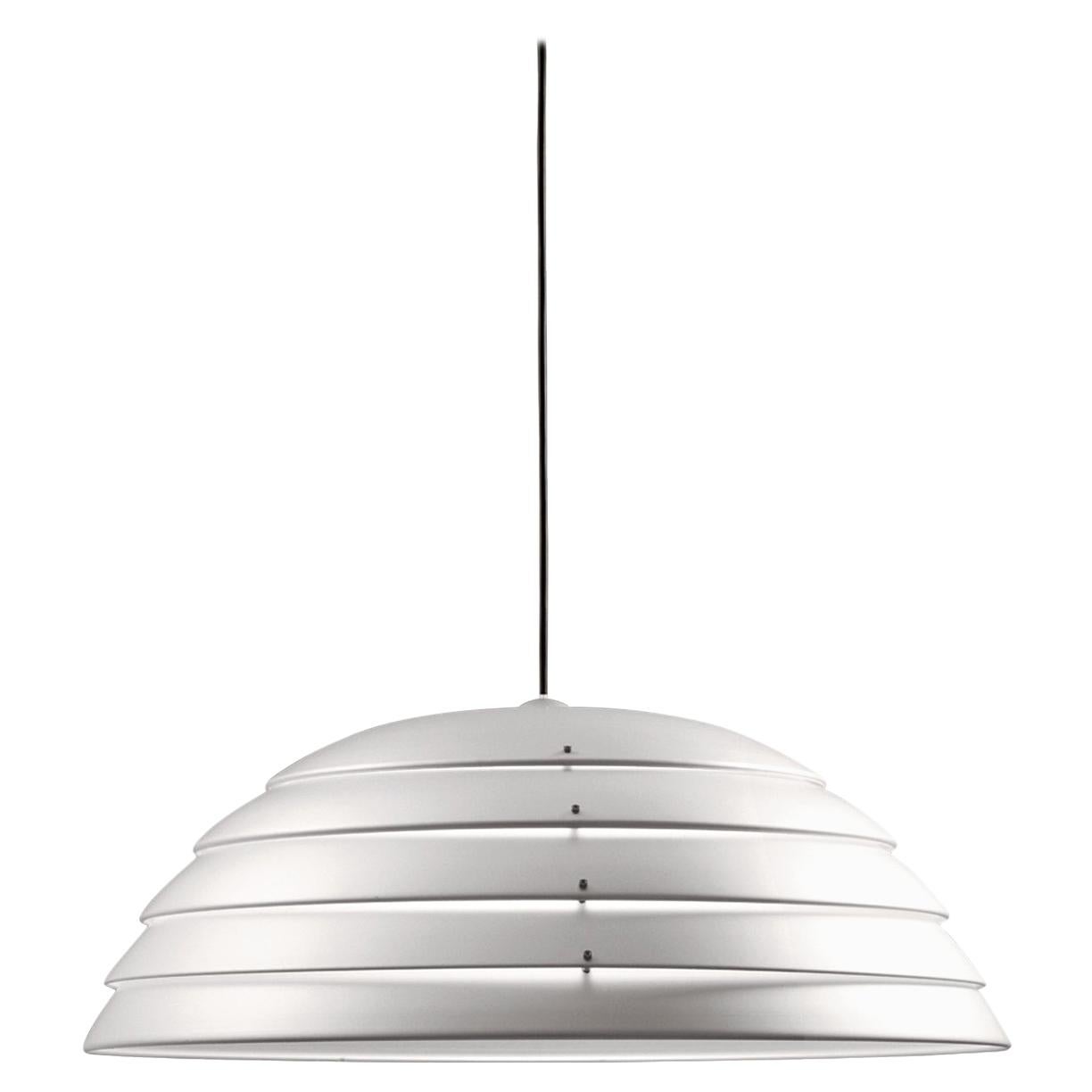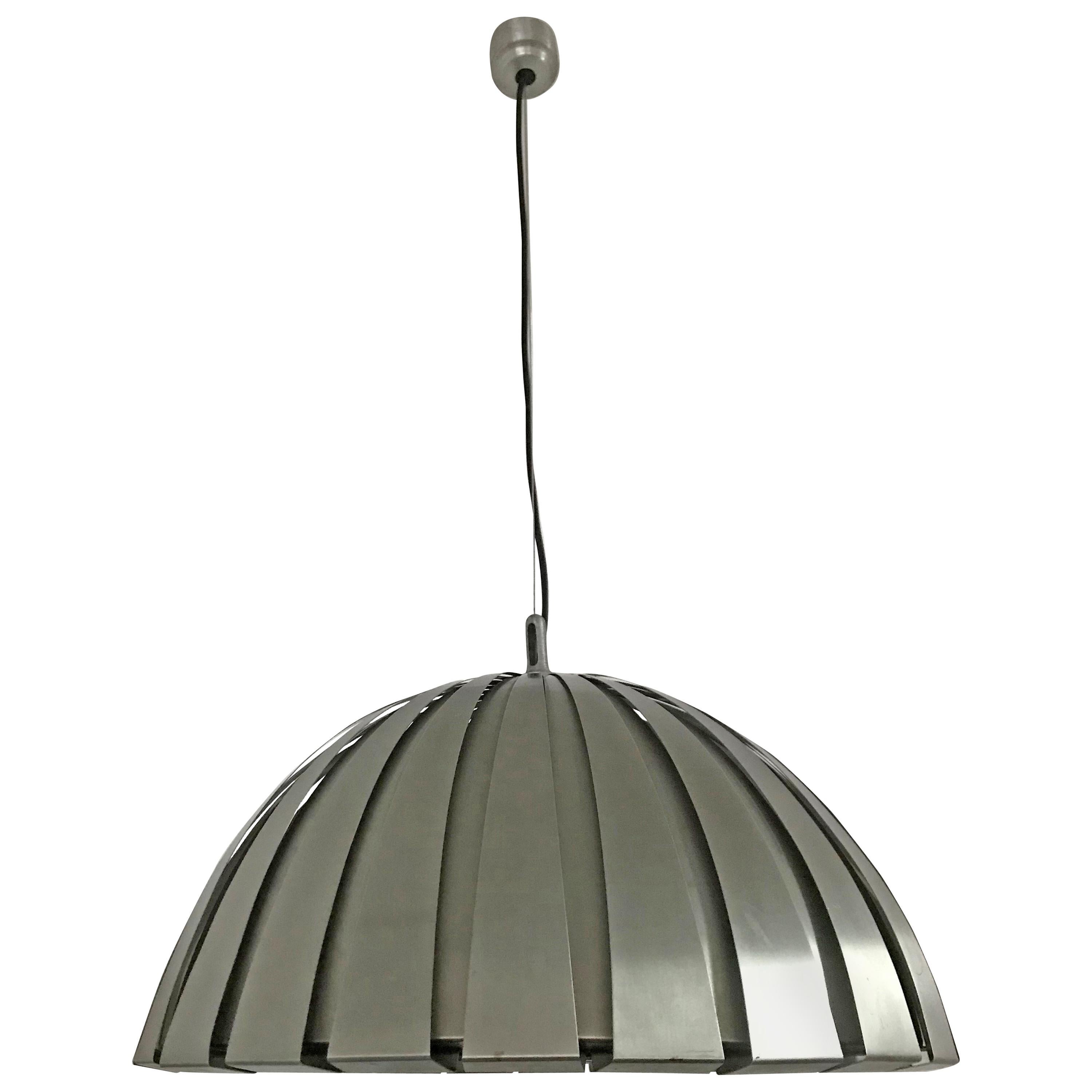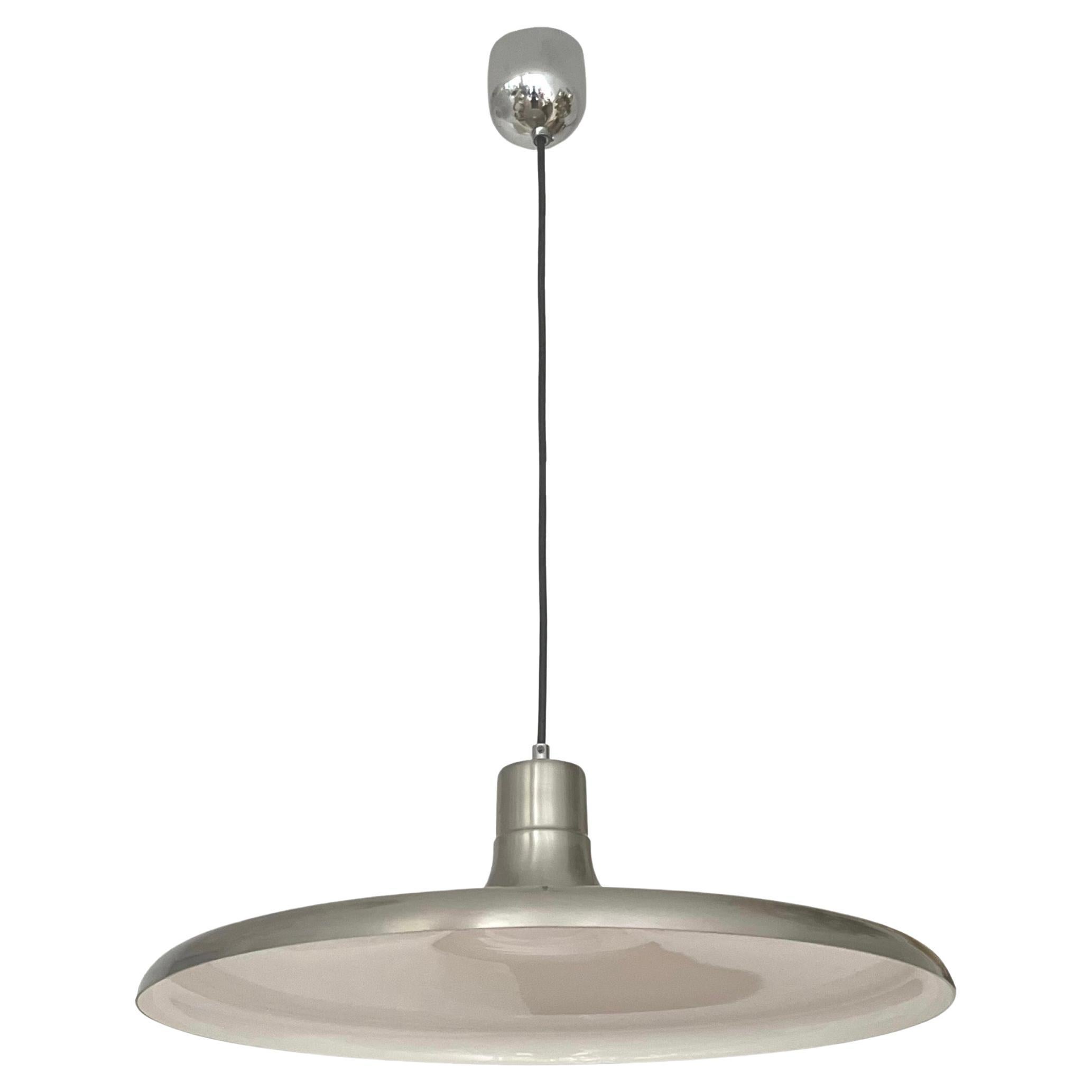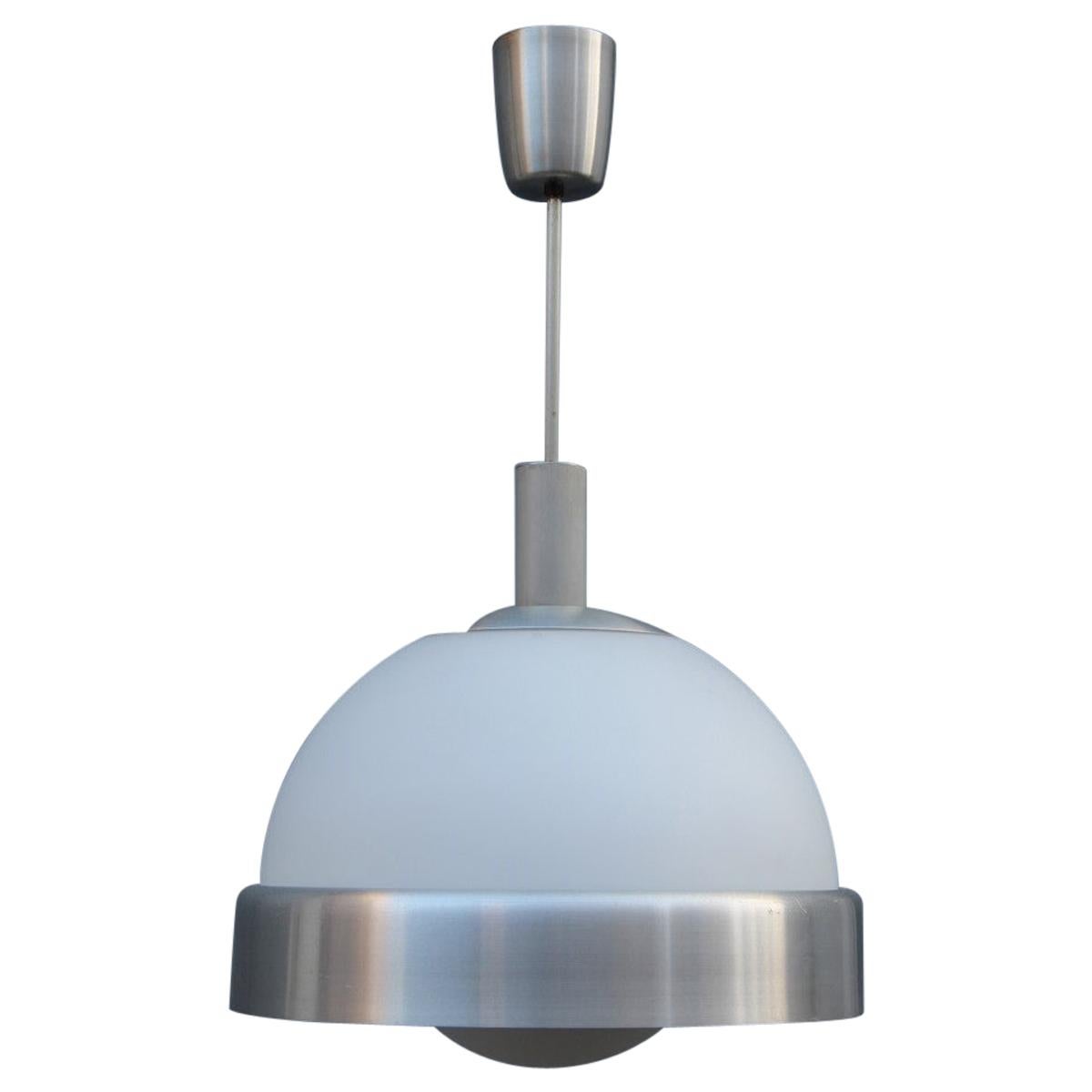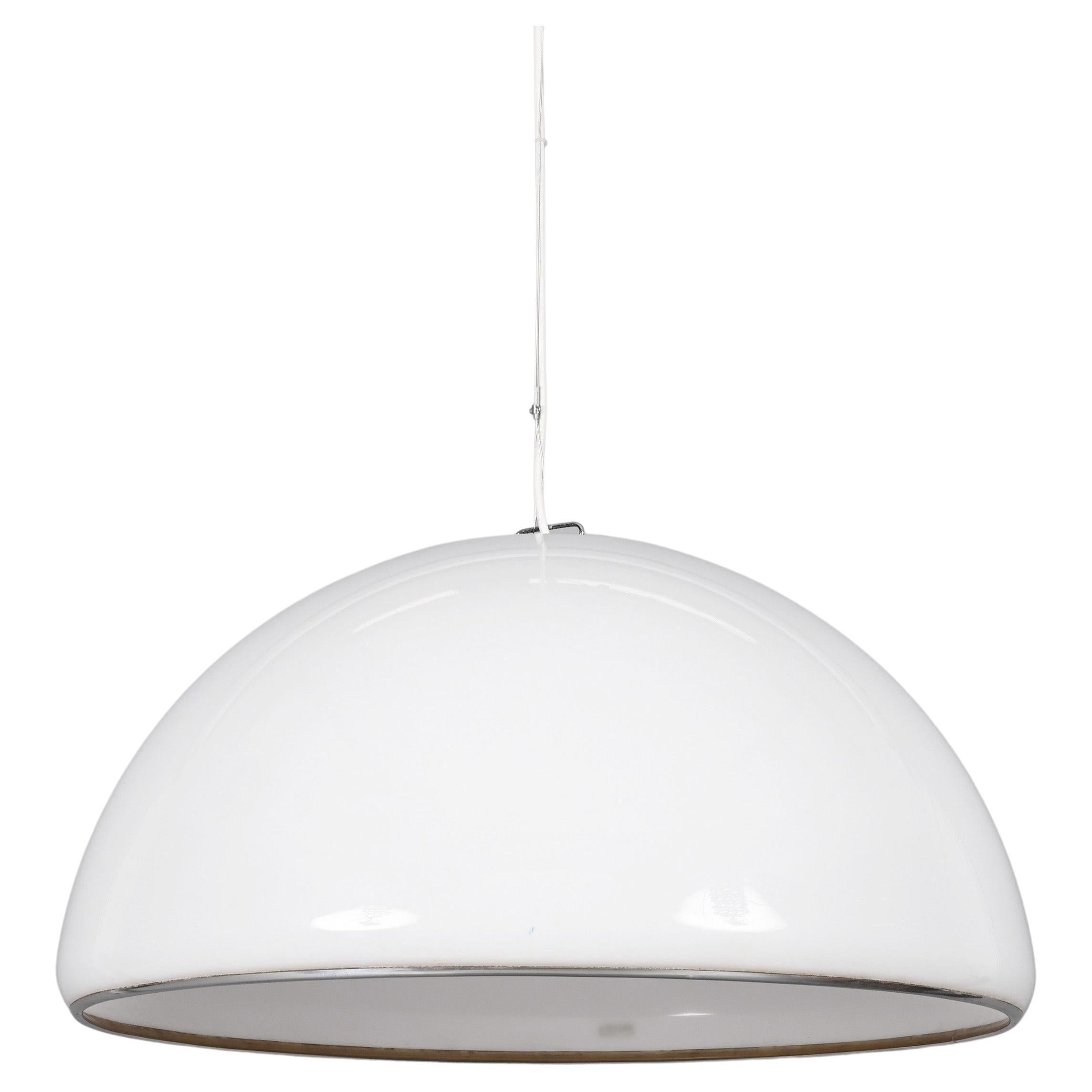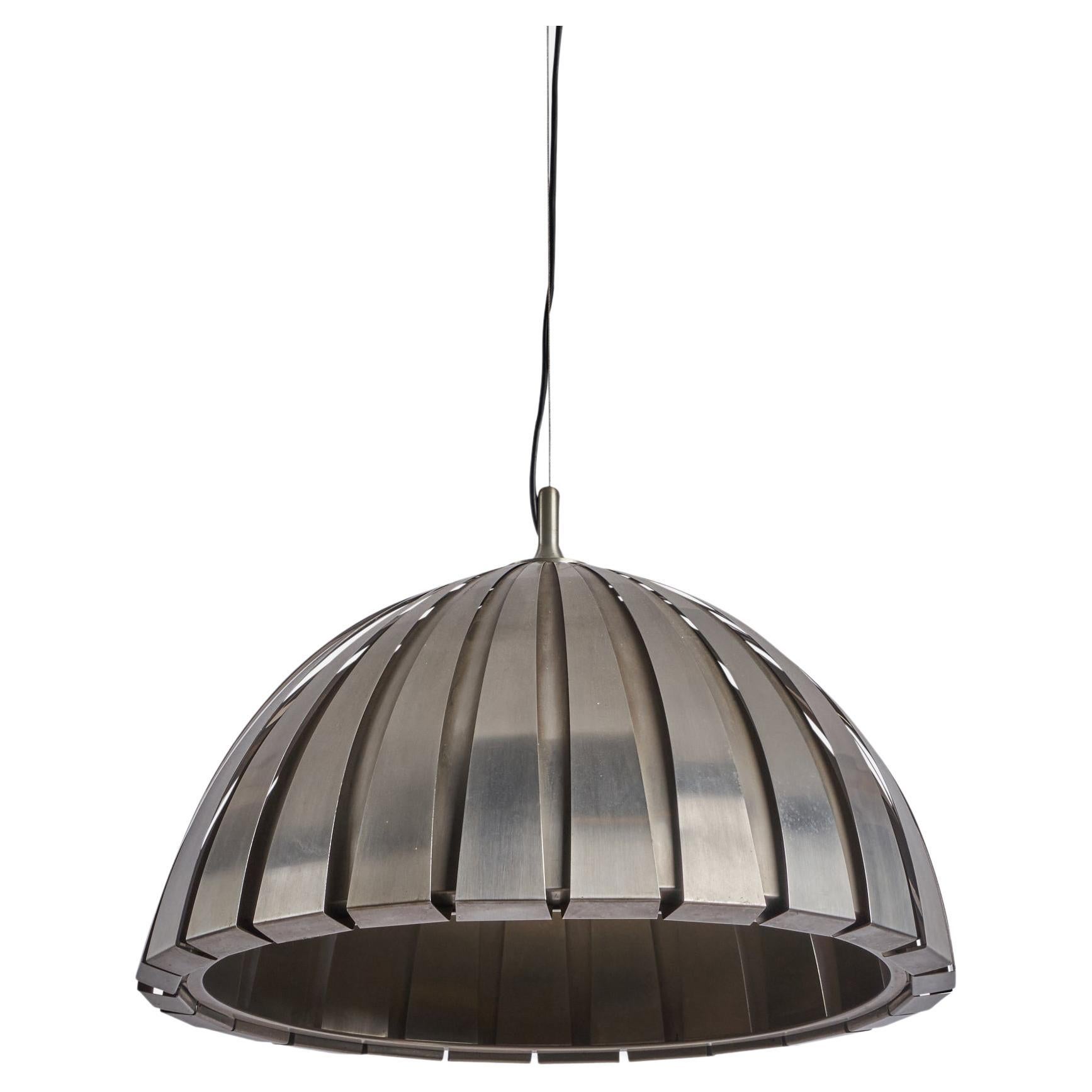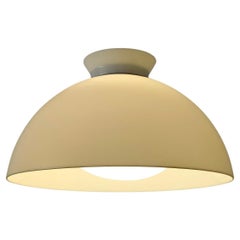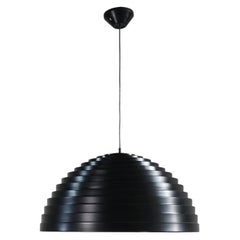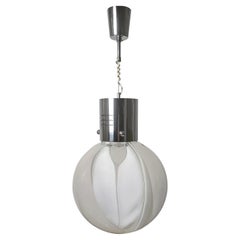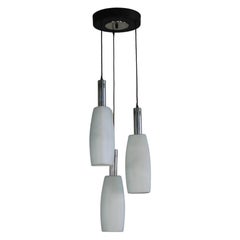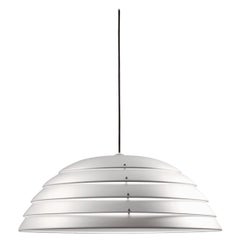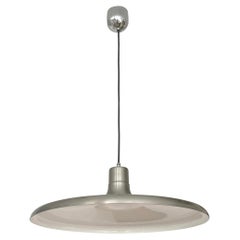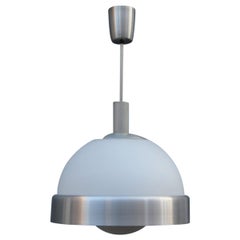Items Similar to Elio Martinelli Step Chandelier in White Lacquered Metal by Martinelli Luce 70s
Want more images or videos?
Request additional images or videos from the seller
1 of 7
Elio Martinelli Step Chandelier in White Lacquered Metal by Martinelli Luce 70s
$3,354.80
£2,497.43
€2,800
CA$4,595.24
A$5,110.91
CHF 2,668.76
MX$62,194.34
NOK 34,084.12
SEK 31,964.89
DKK 21,315.42
Shipping
Retrieving quote...The 1stDibs Promise:
Authenticity Guarantee,
Money-Back Guarantee,
24-Hour Cancellation
About the Item
A rare ceiling lamp or chandelier (model Step) with a semisphere lampshade in white lacquered aluminum, it was designed by Elio Martinelli and produced by the Italian company, Martinelli Luce during the 1970s.
The concentric shapes repeated in a precise sequence, from which the Step lamp is structured, reveal an attitude of the designer in search of geometric essentiality. It is a lamp characterized by simple and functional lines in which all the elements are inserted into each other reducing to a disk a few centimeters high, with closing system and telescopic opening. Its particular metal lamellar structure recalls some of the most famous lamps by Alvar Aalto and the hexagonal lamp designed in 1959 by Bruno Munare for Danese.
Literature: Emiliana Martinelli, Elio Martinelli e Martinelli Luce, Milano, Mondadori Electa, 2018 pg 155.
Over the years the company collaborates with many important designers such as Gae Aulenti Sergio Asti, Richard Neutra, Studio Orlandini, Marc Sadler, Luc Ramael, Studio Lucchi & Biserni, Angelo Micheli, Karim Rashid, Massimo Farinatti, Paola Navone, Alfonso Femia and in recent years young talents such as Brian Sironi, Marco De Santi - Studio Natural, Studio 4P1B, Studio Habits, Adolini+Simonini Associati and many others.
''We believe in the essential, which for us means no frills or unnecessary frills; the lines we design and that give shape and outline to our products, are both the minimum and the maximum. It is not simply a matter of design: is design concept and production philosophy.
We want to stimulate new points of view by inspiring through our products the curiosity and creativity of people; whether they are engineers, architects, dealers or simply private. To make them see with new eyes what appears to them daily as ordinary.
Through these simple and priceless values for us we are able to remain faithful to the creative culture that pervades every project or product. ''
- Creator:Elio Martinelli (Designer),Martinelli Luce (Manufacturer)
- Dimensions:Height: 15.75 in (40 cm)Diameter: 27.56 in (70 cm)
- Power Source:Hardwired
- Lampshade:Included
- Style:Post-Modern (Of the Period)
- Materials and Techniques:Metal,Lacquered
- Place of Origin:
- Period:
- Date of Manufacture:1977
- Condition:Wear consistent with age and use.
- Seller Location:Montecatini Terme, IT
- Reference Number:1stDibs: LU5304235159572
About the Seller
4.9
Vetted Professional Seller
Every seller passes strict standards for authenticity and reliability
1stDibs seller since 2020
123 sales on 1stDibs
Typical response time: 1 hour
- ShippingRetrieving quote...Shipping from: Borgo a Buggiano, Italy
- Return Policy
Authenticity Guarantee
In the unlikely event there’s an issue with an item’s authenticity, contact us within 1 year for a full refund. DetailsMoney-Back Guarantee
If your item is not as described, is damaged in transit, or does not arrive, contact us within 7 days for a full refund. Details24-Hour Cancellation
You have a 24-hour grace period in which to reconsider your purchase, with no questions asked.Vetted Professional Sellers
Our world-class sellers must adhere to strict standards for service and quality, maintaining the integrity of our listings.Price-Match Guarantee
If you find that a seller listed the same item for a lower price elsewhere, we’ll match it.Trusted Global Delivery
Our best-in-class carrier network provides specialized shipping options worldwide, including custom delivery.More From This Seller
View AllAchille & Pier Giacomo Castglioni KD6 Hanging Lamp for Kartell 1959 Italy
By Kartell, Achille & Pier Giacomo Castiglioni
Located in Montecatini Terme, IT
The hanging lamp model "KD 6” was designed by the brothers Castiglioni and was among the first lamps produced by the famous Italian company Kartell.
KD 6 lamp ...
Category
Vintage 1960s Italian Mid-Century Modern Chandeliers and Pendants
Materials
Brass
Elio Martinelli Step Chandelier in Black Lacquered Metal by Martinelli Luce 70s
By Elio Martinelli, Martinelli Luce
Located in Montecatini Terme, IT
A rare ceiling lamp or chandelier (model Step) with a semisphere lampshade in black lacquered aluminum, it was designed by Elio Martinelli and produced by the Italian company, Martinelli Luce during the 1970s.
The concentric shapes repeated in a precise sequence, from which the Step lamp is structured, reveal an attitude of the designer in search of geometric essentiality. It is a lamp characterized by simple and functional lines in which all the elements are inserted into each other reducing to a disk a few centimeters high, with closing system and telescopic opening. Its particular metal lamellar structure recalls some of the most famous lamps by Alvar Aalto and the hexagonal lamp designed in 1959 by Bruno Munare for Danese.
Literature: Emiliana Martinelli, Elio Martinelli e Martinelli...
Category
Vintage 1970s Italian Post-Modern Chandeliers and Pendants
Materials
Metal, Aluminum
Toni Zuccheri Membrana Ceiling Lamp in Murano Glass by Venini 1960s Italy
By Venini, Toni Zuccheri
Located in Montecatini Terme, IT
Ceiling or Hanging lamp from the 'Membrane' series, designed by Toni Zuccheri and created between 1966 and 1968 by the famous Italian company Venini.
The lamp presents a round sha...
Category
Vintage 1960s Italian Mid-Century Modern Chandeliers and Pendants
Materials
Metal
Stilnovo Chandelier with Lampshades in Opaline Glass Italian Manufacture 1970s
By Stilnovo
Located in Montecatini Terme, IT
Chandelier with three lampshades in opaline glass and a structure in enameled and nickel-plated metal.
Manufactured by Stilnovo in 1970s Italy.
Stilnovo was an important lighting c...
Category
Vintage 1970s Italian Mid-Century Modern Chandeliers and Pendants
Materials
Metal
Gaetano Missaglia Ceiling Lamp with Lampshades in Lucite Plexiglass 1970s Italy
By Gaetano Missaglia
Located in Montecatini Terme, IT
Mid-Century Modern ceiling lamp with five lampshades in chromed metal and lucite plexiglass.
Designed by Gaetano Missaglia and manufactured in Italy during the 1970s.
Acrylic, also known as the brand names lucite or Plexiglas, was developed in the 1930s. Its scientific name is Poly(methyl methacrylate), or PMMA, and it is a type of thermoplastic, which is a plastic Material that is moldable at extremely hot temperatures and solid once cool.
The company that created acrylic licensed it in two ways; first as Plexiglas to be a glass replacement, and afterwards as lucite for commercial uses in 1937. Commercially, lucite was used in jewelry, handbags, and cosmetics packaging. Plexiglas, in comparison, was often used for larger projects, such as aircraft windows, lenses for lighthouses, and aquariums.
Before it was used widespread for furniture, acrylic was being utilized for military purposes, as wartime was quickly approaching. During World War 2 (1939-1945), the country’s resources were mostly directed to military uses, and acrylic was no different. Acrylic, as Plexiglas, was used to help the military, including as airplane windshields and submarine periscopes.
Despite that, some people began using acrylic to make furniture. In 1939, Helena Rubinstein, a wildly successful cosmetics mogul and art collector, commissioned to Ladislas Medgyesan an entire suite of acrylic furnishings for her NYC apartment, including an illuminated acrylic bed in her bedroom and acrylic chairs for business meetings.
When the war ended in 1945, acrylic was ready to be worked with in design on a larger scale. The company licensed lucite widely, making it much more available across every industry. It steadily gained momentum in the world of design, with artists and designers being inspired by its moldability and translucense. In 1959, French designer Erwine Laverne told a New York Times reporter, “The most important element in rooms is people, not furniture,” speaking to the growing popularity and importance of the clear furniture.
But acrylic furniture hit its peak popularity in the 1960s and ‘70s, as more acrylic furniture designers and artists entered the scene. Glass artists began to take more of an interest in acrylics, especially taking advantage of acrylic’s flexibility, light weight, cost, and capacity to refract and filter light. Designers like John Mascheroni and Charles Hollis Jones, known as the Godfather of lucite, created iconic pieces that still look beautiful in today’s modern home.
Designers and artists alike loved the durability and look of acrylic. As Charles Hollis Jones put in an interview with Ravelin Magazine,
“I worked a lot with lucite when I first started. When I worked with the company that wanted me to go to Europe, they had me work with glass, ceramic, enamel. I went over there and the glass was always in the wrong color and it always broke. When the earthquakes came, I got visual proof of that. I like to work with acrylic because it does two wonderful things that glass doesn’t. It’s shatter-proof, first of all. I can also change the microstructure and make it one-tenth the strength of steel. And the most important thing it does: it carries light. Glass reflects light. lucite holds it and carries it. If you play with it, you can make a lens to look at something in space. It’s that good. It’s purer than crystal.”
In fact, acrylic was often used in chandeliers as well, mixed with other materials to make incredible striking designs that would have been much more difficult to achieve with glass.
Recently, acrylic furniture has once again risen in popularity. While many of the designs are timeless, more designers are coming forward with acrylic furniture for the modern home. In 2002, designer Philippe Starck introduced his Louis Ghost Chair, and the trend has only grown from there.
You’ll now find entirely acrylic pieces of home furnishings and accessories, as well as acrylic-detailed furniture all across the market. With so many designs, options, and knock-offs all across the market, we at clear home design...
Category
Vintage 1970s Italian Mid-Century Modern Chandeliers and Pendants
Materials
Metal
Pendant Lamp with Five Elements in Opaline Glass by Stilnovo 1960s Italy
By Stilnovo
Located in Montecatini Terme, IT
Pendant lamp with structure in lacquered metal and brass and five diffusers in opaline glass.
This lamp was manufactured by the Italian company Stilnovo during the 1960s.
Stilnovo w...
Category
Vintage 1960s Italian Mid-Century Modern Chandeliers and Pendants
Materials
Brass, Metal
You May Also Like
Martinelli Luce Cupolone 1889 Pendant Light by Elio Martinelli
By Elio Martinelli, Martinelli Luce
Located in Brooklyn, NY
Hanging lamp direct light. Structure in white lacquered Aluminum. Composed by 5 superimposed elements, fixed with little bottons. For Led bulb.
Technical specifications
Materials...
Category
21st Century and Contemporary Italian Modern Chandeliers and Pendants
Materials
Aluminum
Mid-Century Modern Stainless Steel Chandelier, Martinelli Luce, Italy
By Elio Martinelli, Martinelli Luce
Located in Merida, Yucatan
Space age pendant lamp, Model Calotta 1749 designed by Elio Martinelli for Martinelli Luce, in brushed stainless steel, still holding the original sticker.
Category
Vintage 1970s Italian Space Age Chandeliers and Pendants
Materials
Stainless Steel
Mid-century Metal Chandelier by Leonardo Marelli for Estiluz, 1970s
By Leonardo Marelli, Estiluz, Estiluz Lighting
Located in Badajoz, Badajoz
Mid-Century Metal Spanish Chandelier by Leonardo Marelli for Estiluz. This Chandelier was designed and manufactured in Barcelona (Spain) during 1970s. Interior white Lacquered.
The c...
Category
Vintage 1970s Spanish Mid-Century Modern Chandeliers and Pendants
Materials
Metal
$944 Sale Price
20% Off
Pia Guidetti Crippa Chandelier for Lumi Milano 1970s Italian Design White Glass
By Pia Guidetti Crippa
Located in Palermo, Sicily
Pia Guidetti Crippa chandelier for Lumi Milano 1970s Italian design white glass, aluminum Parts.
Category
Vintage 1950s Italian Mid-Century Modern Chandeliers and Pendants
Materials
Aluminum
$2,108 Sale Price
20% Off
Mid-Century Harvey Guzzini Metal and White Plexiglass Italian Chandelier, 1970s
By Harvey Guzzini, iGuzzini, Guzzini
Located in Roma, IT
Fantastic mid-century Guzzini metal and white plexiglass chandelier. Harvey Guzzini designed this fantastic piece in Italy during the 1970s.
This amazing item is fantastic thanks to its pure and smooth lines combined with clean materials.
An astonishing pendant lamp that will enrich a midcentury living room or kitchen. The item is perfect for a spacage space too.
Harvey Guzzini is often mistakenly thought to be the name of a lighting designer active in the 1960s and 1970s. But in fact, the label belongs to a lighting manufacturing company, which was founded by six Guzzini brothers—Raimondo, Giovanni, Virgilio, Giuseppe, Adolfo and Giannunzio—who were inspired by the 1950 film Harvey starring James Stewart. Compounding the historical record even further, it seems that the Guzzini company rebranded many times in the 20th century, going by, at various points, Harvey Creazioni, Harvey Guzzini, Guzzini, iGuzzini, and Illuminazione Guzzini.
Harvey Creazioni was originally founded in 1959 in Recanti (on the east-central coast of Italy) by Raimondo, focusing on the production of copper-plated decorative objects. Four years later, in June 1963, the six brothers joined together and established Harvey Creazioni di Guzzini, expanding production to include pendant lighting, sconces, and lamps, floor lamps. The brothers employed architect-designer Luigi Massoni—who was introduced to the Guzzini brothers by leading plastic importer Maurizio Adreani—as head of design, branding, public relations, and advertising.
Famous Harvey Guzzini designs include Massoni and Luciano Buttura's Mushroom Table Lamp (1965), as well as the in-house designed Arc Floor Lamp (1968), Faro Table Lamp (1970), and Toledo Table Lamp (1973). Studio 6G, an interning design team, developed the collectable Clan Table Lamp (1968); and designers Ermanno Lampa and Sergio Brazzoli were responsible for the Nastro Series (1970), Orione Pendant (1970), Sirio Table Lamp (1970), Alba Floor Lamp (1973), Albanella Table Lamp...
Category
Vintage 1970s Italian Mid-Century Modern Chandeliers and Pendants
Materials
Metal
Elio Martinelli, Pendant Light, Aluminium, Metal, Italy, 1970s
By Martinelli Luce, Elio Martinelli
Located in High Point, NC
An aluminium and metal pendant light designed by Elio Martinelli and produced by Martinelli Luce, Italy, c. 1970s.
Overall Dimensions (inches): 13” H x 22” Diameter
Bulb Specificati...
Category
Vintage 1970s Italian Modern Chandeliers and Pendants
Materials
Metal, Aluminum
More Ways To Browse
Used Elio
70s White Furniture
70s Lacquer
Martinelli Luce Vintage
Studio Luce
Luce Furniture Company
Elio Martinelli For Martinelli Luce
Neutra Richard
Sergio Asti Marco
Adolini Simonini
Silk Canopy
Stilnovo Frosted Glass
Swedish Iron Chandelier
Terra Pendant
Verdigris Chandelier
1900 Pendant Light Fixtures
Achille Castiglioni Resin
Blown Glass Bubble Chandelier 1970
